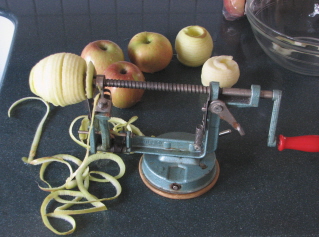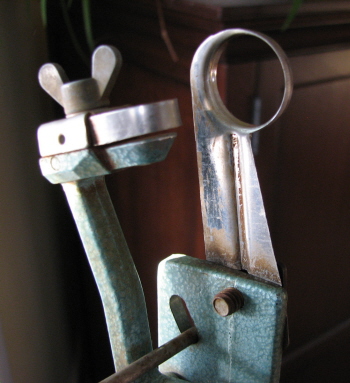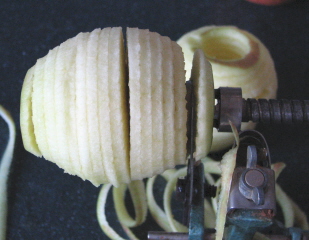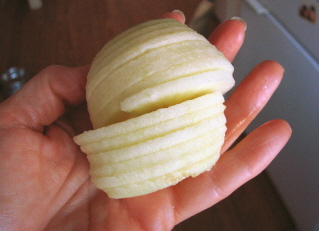Last weekend I had some friends over for dinner, and I was in a quandary as to what to make for dessert. These quandaries usually start with inadequate planning and are complicated by my desire not to return to the grocery store, and that was the case this time. It came down to something with apples or chocolate.
I decided to do something simple, apple pie.
Now, some people might say the only easy apple pie is one made by Mrs. Smith or brought home from the bakery. Those are the people who do not own an apple-peeler-corer-slicer like mine.
They think that making a pie requires hours of manually peeling, slicing and coring and earning aching wrists and thumbs for their trouble. That’s where they’re mistaken.
Here’s how the apple machine works: You fasten the machine to the counter (I can’t imagine the clamp-on type works as well as the vacuum cup, but both options are available), push the apple onto prongs at the end of the spindle, and turn the crank.
First the apple gets peeled by the curved blade at top left in the photo below. The spring-loaded arm keeps constant, steady pressure on the apple as it rotates.
Then, the apple passes through the sharp, circular corer while the vertical blade (that’s the slanted edge of the corer piece) slices it. You end up with a peeled, cored apple:
Actually, you wind up with a really long apple coil, at least some of the time. A quick vertical slice through the middle and you’ve got two piles of half-moons, each about 3/16 inch thick (4-5 mm), I’d say.
It’s brilliant, to my way of thinking. It is not, however, perfect.
For instance, for this week’s pie I used Fuji apples (a first) which, it turns out, have seeds a little farther from the center than some other apples, meaning I had to manually remove some husks that the machine left behind.
It works best if the apple is uniformly shaped and firm. I’m sure there’s an industrial apple bred exactly for such a purpose. I just don’t seem to buy them. If the apple is soft, you have to manipulate the peeling blade arm to reduce pressure some. If the apple’s too lopsided, one part or another might not get peeled. And so on.
Big deal, I say. It’s still a breeze compared with doing it by hand. Of course, I’ve used mine so much that I may be due for a new one. The suction cup doesn’t grip any more, at least not very well. The blades aren’t quite as sharp as they once were but, hey, neither am I.
The machine almost makes the phrase “easy as pie” make sense, and I say hooray for that. Meanwhile, I’m happy to report that Fujis worked fine. They’re so juicy, I was afraid I’d have a runny pie, so I held back a touch on the sugar (they’re quite sweet anyway) and used a tad more flour in the filling. It was perfect.
I probably need to go down to the hardware store and buy a replacement apple machine. You can see several options at Amazon if you want one, too. Mine’s a Norpro.
Added bonus: If you’re especially thrifty and domestic, you can use the apple peels to make your own pectin for jellies.





Joanne // Mar 17, 2008 at 5:22 pm
I bought one of these used about 5 years ago, and it is worth its weight in umm, apples? I love it. I use it all the time…but have never gotten the peeler to work effectively, which doesn’t bug me, because peel (on organic apples) is not bad for you! I am actually considering the purchase of a new one. It’s one of my favorite gadgets…and my apples are never the perfect industrial type-whatever that is!
Janet Majure // Mar 18, 2008 at 8:11 am
It’s true the peeling part is the least consistent on mine, too, but I suspect a sharpened blade would help. Still, unless the flesh is quite soft, it does a passable job, and if I’m picky, I can always do “cleanup” peeling after I’ve run it through the “apple twirler,” as my daughter called it when she was little.